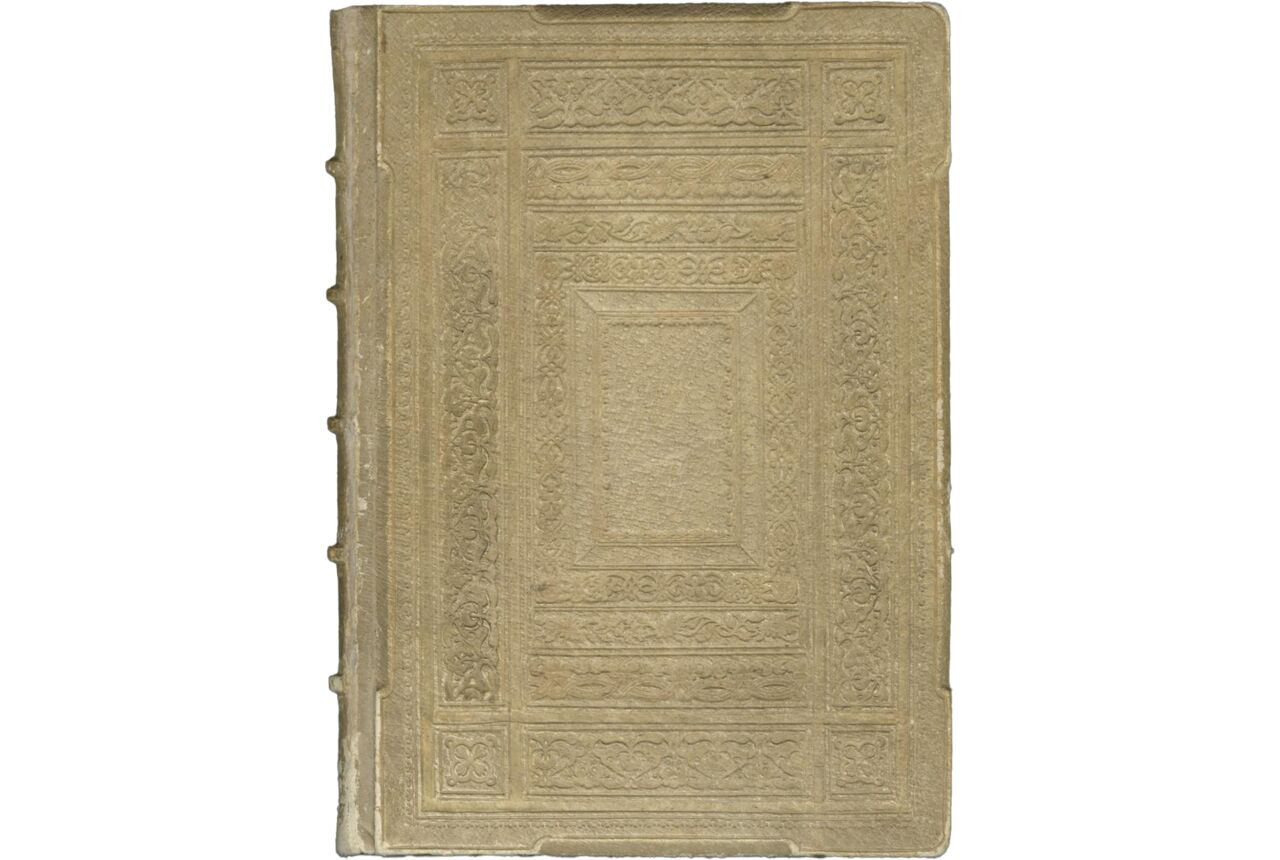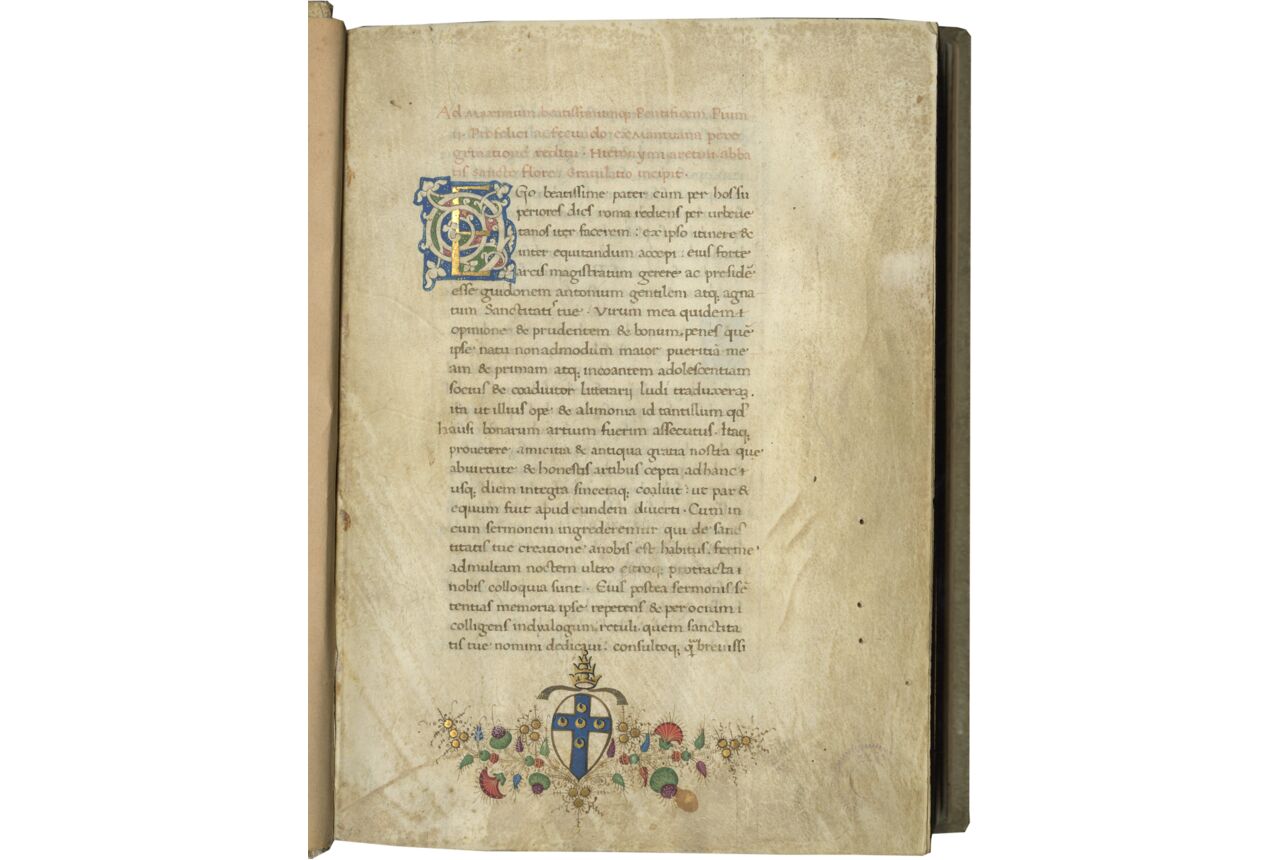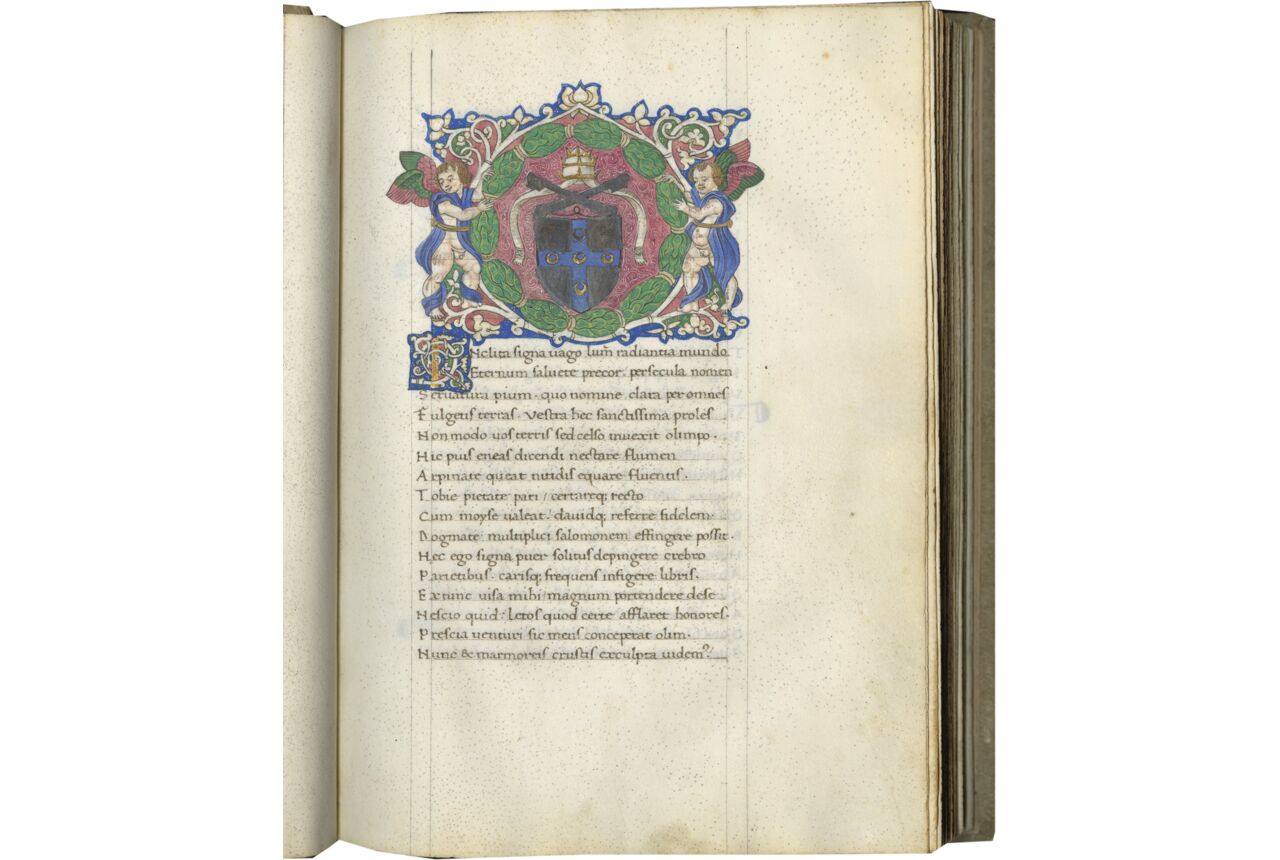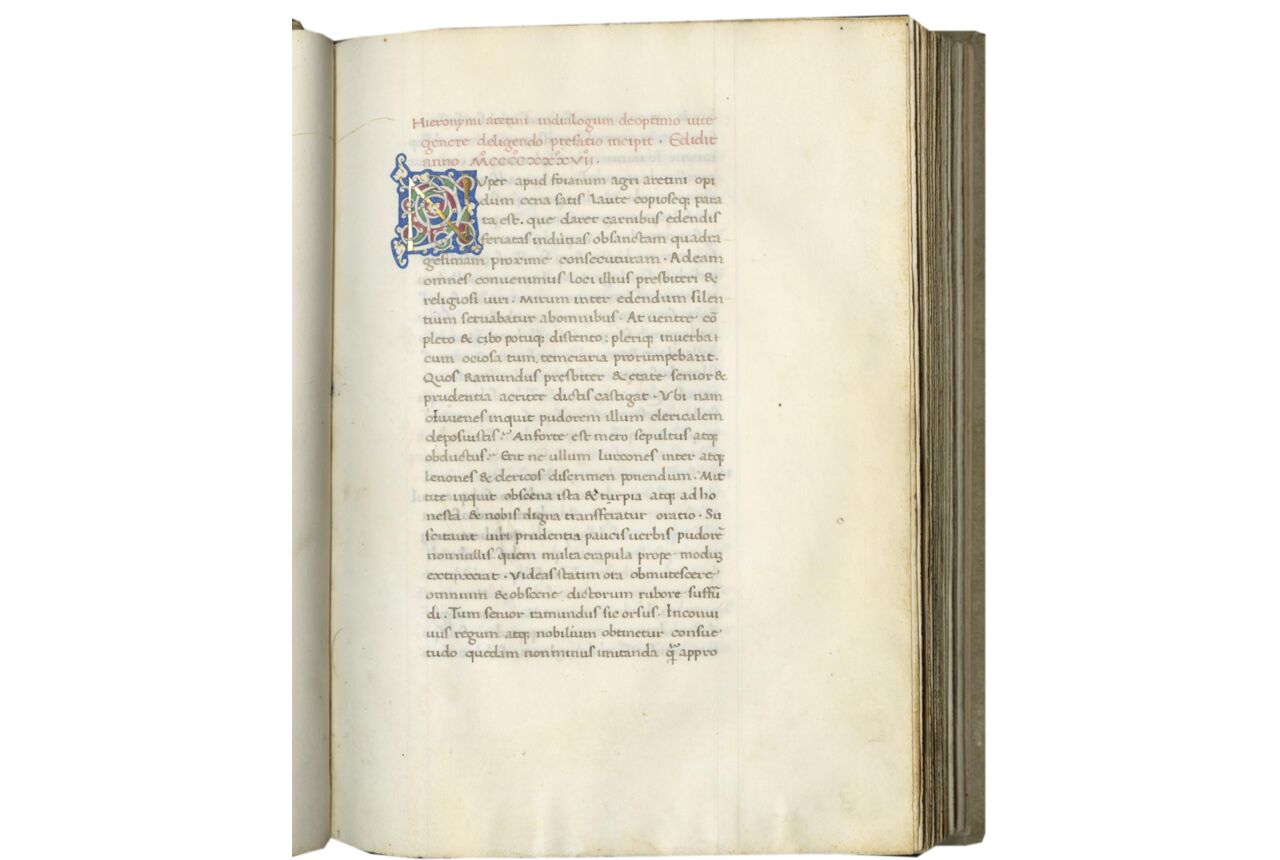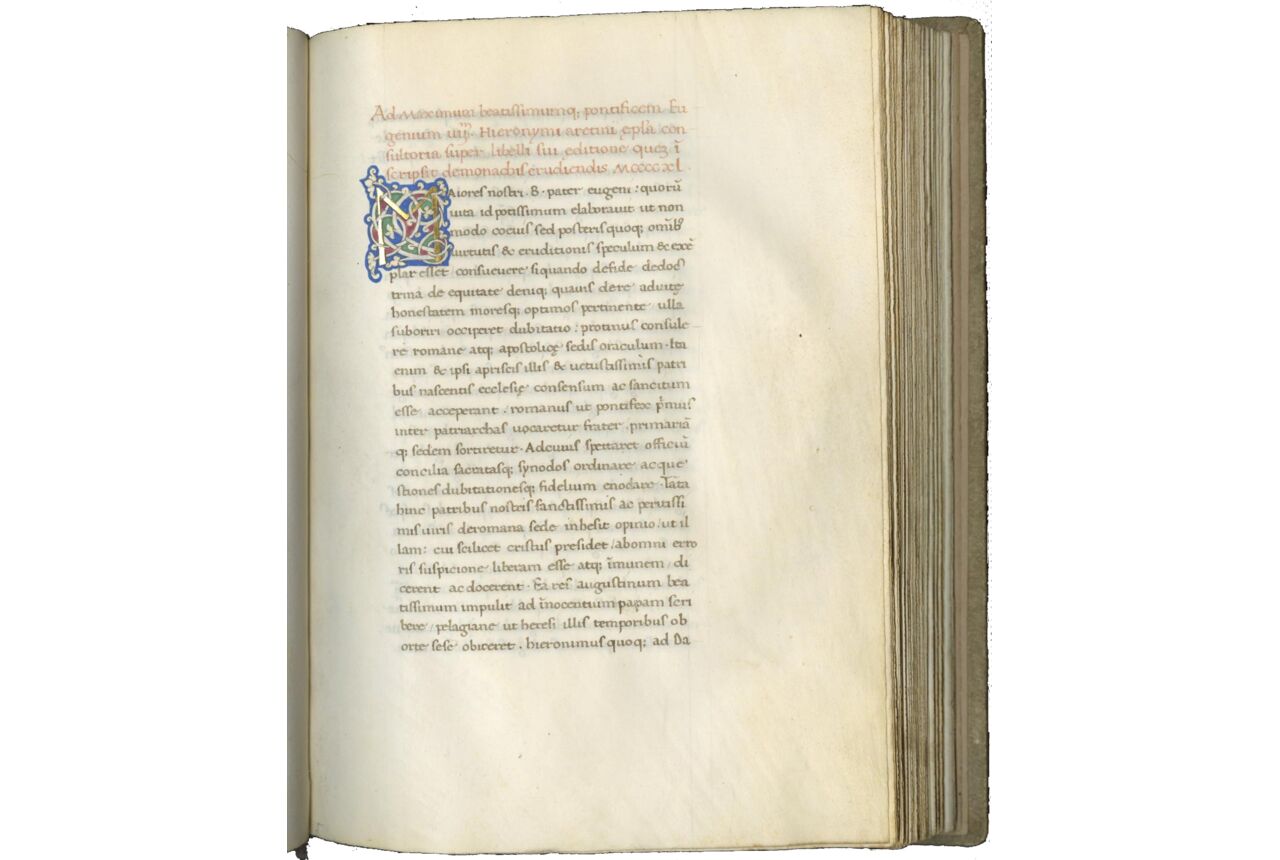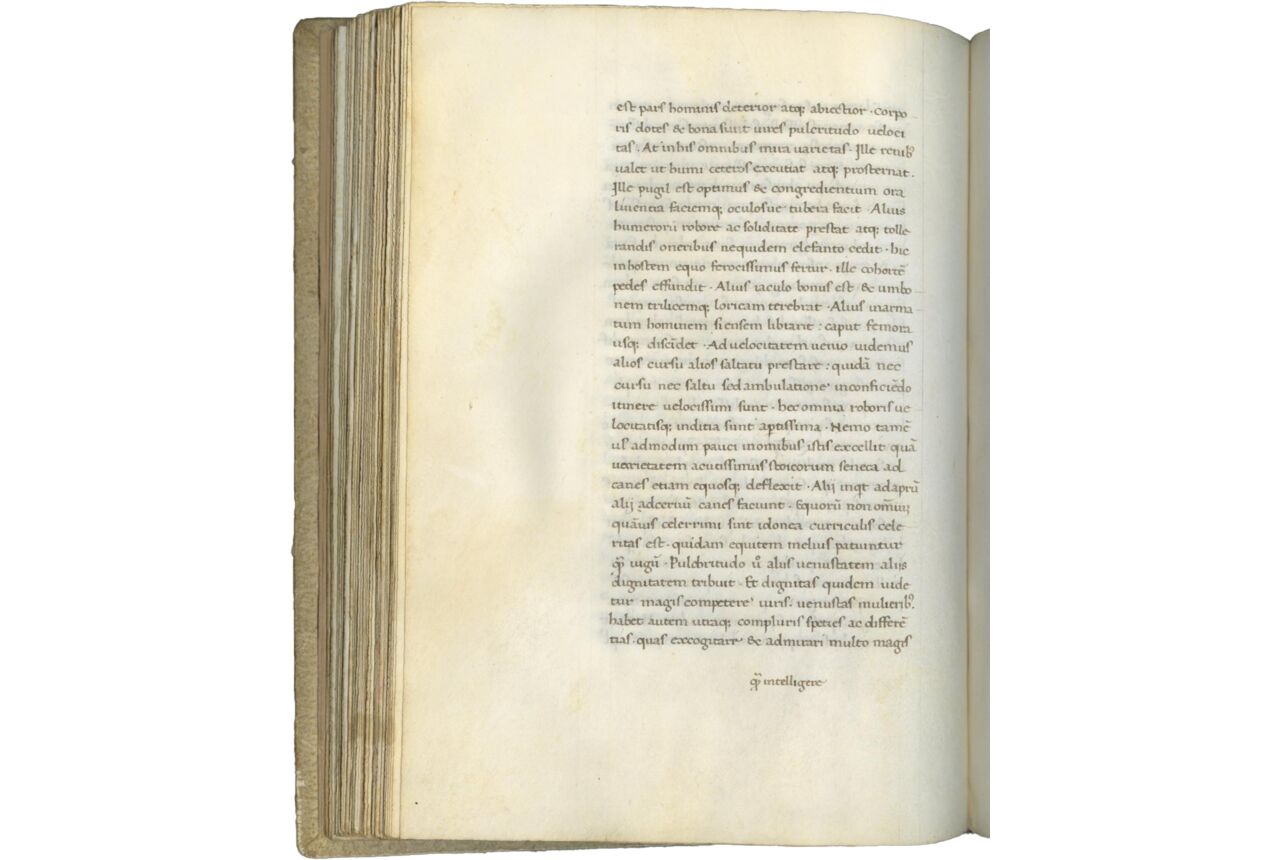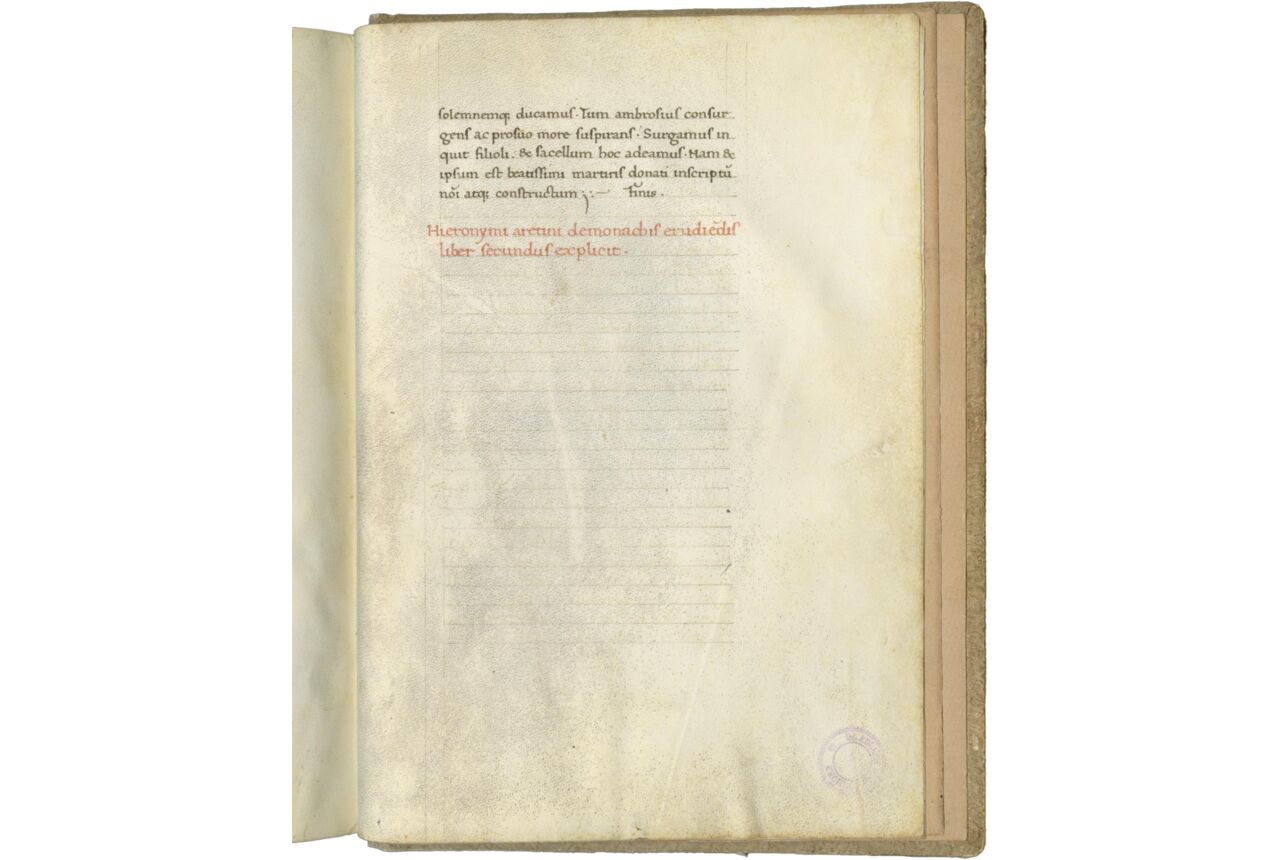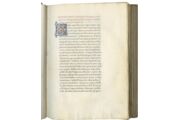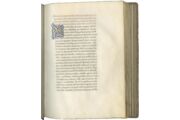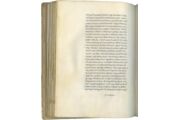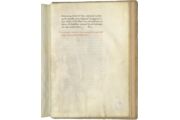ii (paper, i marbled on recto) + 139 + ii (paper, ii marbled on verso) folios on parchment, modern foliation in pencil top outer corner recto (collation i-xiii10 xiv10 [-10, cancelled blank]), horizontal catchwords center lower margin except quires 2 and 4, ruled lightly in brown ink with double vertical bounding lines full across (justification 164 x 90 mm.), written in brown ink in a formal humanistic script in 28 long lines, headings and names of interlocutors in pale red, occasional one-line paragraph marks in blue, fourteen smaller gold initials on blue, red, and green grounds with white tracery, FIVE WHITE-VINESTEM INITIALS 4- to -6-lines, TWO ILLUMINATED COATS OF ARMS (described below), soiling on f. 1, four small round wormholes in outer margins at the beginning, reducing to one after f. 12 and disappearing after f. 46, occasional slight staining, browning, and cockling, a tear and an old parchment repair in outer margin of f. 109, another old parchment repair in lower margin of f. 133, else in excellent condition. Early twentieth-century German blind-tooled pigskin binding over wooden boards, spine with four raised bands, edges gilt and gauffered, upper joint skillfully repaired. Dimensions 253 x 181 mm.
In all respects, this deluxe illuminated manuscript exemplifies the importance of patronage in Italian Renaissance culture. The author of the texts, Girolamo Aliotti, commissioned it from Vespasiano da Bisticci, the “king of booksellers,” for presentation to Pope Pius II. Wholly worthy of this learned, humanist pope, this manuscript contains three erudite humanist texts (including one specifically composed for this manuscript to flatter the pope). The highest quality parchment was used to show off an elegant humanist script with wide margins and skillful illumination. The celebrated Florentine artist, Filippo di Matteo Torelli, executed the very fine white vinestem initials and the Pope’s coats of arms.
Provenance
1. Commissioned in Florence from the renowned bookseller, Vespasiano da Bisticci, by the author, Girolamo Aliotti, and presented to Pope Pius II (Enea Silvio Piccolomini) in 1460.
2. There is no evidence that this was ever in the official papal library, and it likely remained in Piccolomini’s private collection in Siena, which was passed down through his heirs. Pius II’s books were later dispersed, and manuscripts bearing his papal coat of arms are presently scattered across various European and American libraries.
3. In Germany by the late nineteenth or early twentieth century, when the manuscript was rebound in its current binding, and likely the small round stamp, “Dr. Adolph […]horn,” was added to the title page and f. 138.
4. Belonged to Moritz Diesterweg (1834-1906), publisher and bookseller in Frankfurt; envelope pasted to the verso of the first flyleaf contains half a card from Diesterweg with some penciled notes (‘Pius II Aeneas Sylvius Piccolomini in humanistischen Minuskel geschrieben, sehr gut erhalten’) and a folded piece of thick paper bearing several pencilled notes about the manuscript in German.
5. Private Collection, New York.
Text
ff. 1-19v, Ad Maximum beatissimumque Pontificem Pium II. Pro felici ac secundo ex Mantuana peregrinatione reditu. Hieronymi aretini abbatis sancte flore gratulatio incipit, incipit, “Ego beatissime pater cum per hos superiores dies Roma rediens … meae gratulationis cantus adoriar sic placet”; [ff. 18-19v, 78-verse poem], incipit, “Inclita signa uago lumen radiantia mundo/ …”; [f. 20, blank];
G. Aliotti, Ad Maximum beatissimumque Pontificem Pium II. Pro felici ac secundo ex Mantuana peregrinatione reditu; printed in Aliotti, 1769, vol. 2, 323-345; known in two manuscripts apart from this copy, a miscellany dated 1461, National Library of Florence, Cod. Magl. XXI.151, and Arezzo, Biblioteca Città, MS 400.
The text is written as a fictional dialogue between the pope’s nephew Guidantonio Piccolomini and Aliotti himself concerning a crusade against the Ottoman Turks, who had conquered Constantinople in 1453, a cause that was promoted (unsuccessfully) by Pope Pius II. It ends with a 78-verse poem in praise of Piccolomini and his plea for Christian unity. The Gratulatio thus represents a yet understudied piece of evidence regarding the attitudes of Western intellectuals toward the Turks, along with the Renaissance attitudes on crusading more generally.
ff. 20v-40, [f. 20v, four lines of dedicatory verse to the pope], incipit, “Tum cum feruebat circum precordia sanguis/ …”; [f. 21], Hieronymi aretini in dialogum de optimo uite genere deligendo prefatio incipit. Edidit anno MCCCCXXXVII, “Nuper apud foianum agri aretini opidum … Hiero. Vale o cimber! Mar. valete & reliqui. Finis”;
Aliotti, Dialogus de optimo vitae genere deligendo; ed. Caby, 2012, pp. 461-482. This text, Aliotti’s first humanist composition was written in 1437 and originally dedicated to the bishop of Split (future archbishop of Florence), Bartolomeo Zabarella (d. 1445). Only one manuscript of the 1437 version is recorded, found in a miscellany, Rome, Casanatense Library, MS 4053. The new version in our manuscript, addressed to Pius II, is also found in Arezzo, Biblioteca Città, MS 459, and in Venice, Biblioteca Marciana, MS Marc. lat. XIC.180, (4467).
ff. 40v-138, [f. 40v, four lines of dedicatory verse to the pope], incipit, “Quem semel inuexi summi tunc preslulis aulam/ …”; [f. 41], Ad maximum beatissimumque pontificem Eugenium iiii. Hieronymi aretini epistola consultoria super libelli sui ęditione quem inscripsit de monachis erudiendis MCCCCXL, incipit, “Maiores nostri Beatissimi pater Eugenii …, Plerosque nostrorum temporum religiosos … beatissimi martiris donati inscriptum nomini atque constructum. Finis; [ff. 138v-139, blank].
G. Aliotti, De monachis erudiendis; printed in Aliotti, 1769, volume 2, pp. 176-292. This work, a dialogue composed around 1439, is one of Aliotti’s most well-known works. Divided into two books, it underlines the importance of study to bring about monastic reform. Aliotti originally offered this work to Pope Eugene IV in 1455 in a presentation manuscript, Vatican Library, MS Vat. lat. 1063. The plan to reform monastic life, transforming monasteries into veritable humanistic academies, was well-suited for presentation (in a corrected and revised version) to Pope Pius II, who was himself a champion of humanist causes.
Illustration
Handsomely decorated throughout with five 4- to 6-line fine white vinestem initials, and with two larger miniatures:
f. 1, Papal coat of arms of Pius II Piccolomini (55 x 109 mm.) in shield with the Papal crown above, set within a border of ink tendrils, flowers, leaves, and gold-rayed besants in the bas-de-page (see Borgia, 2005 for the coat of arms);
f. 17, Large miniature (112 x 78 mm.) with the coat of arms of Pius II in burnished silver, blue, and gold surmounted by the papal keys and a white and gold tiara and surrounded by a laurel wreath held by two muscular winged putti, bordered in white vinestem against deep blue, green, and dark pink.
The manuscript is copied on very high-quality parchment in an elegant humanistic script by a yet unidentified scribe. The illumination, and in particular the larger papal coat of arms on f. 17, has been attributed to the renowned Florentine artist, Filippo di Matteo Torelli (1408/10-1468), based on a comparison with other manuscripts produced by Vespasiano for the Medicis in 1458-1464, including Florence, MSS Bib. Medicea Laurenziana, Plut 63.10-12 and Plut. 12.19, both of which include elaborate white vinestem borders and Torelli’s distinctive putti (Govi and Palumbo, Online Resources, includes further references and additional comparisons; Garzelli, 1985, vol. 1, pp. 33-36; De la Mare, 1985, pp. 427-8, 530, and 570; on the artist, see also Galizzi, 2004). Torelli, known for his border decoration, also illuminated manuscripts for the Duomo in Florence, and for the Dominicans of San Marco, collaborated with Lorenzo Monaco, and influenced Florentine artists in the next generation, including Francesco di Antonio di Cherico and Ricciardo di Nanni.
This deluxe illuminated manuscript, offered as a gift by the abbot and humanist Girolamo Aliotti to Pope Pius II Piccolomini, and produced in the Florentine workshop run by the “king of booksellers” Vespasiano da Bisticci, underlines the importance of patronage in Renaissance Italy. Girolamo Aliotti (1412-1480), a native of Arezzo and, from 1446, prior of the Benedictine monastery of St. Flora and St. Lucilla, was a zealous self- promoter who regarded his literary production as a “monnaie d’échanges de faveurs” (Caby, 2018, p. 298). He had become acquainted with the Sienese humanist Enea Silvio Piccolomini (1405-1464), one of the most interesting and multifaceted figures of the Italian Renaissance, when they were both studying in Siena. Piccolomini, a diplomat and a prolific writer, was elected pope in 1458 and took the name of Pius II.
At the beginning of 1460, Aliotti began writing the Gratulatio ad Pium II pro foelici, ac secundo ex Mantuana peregrinatione reditu to present to the pope in a luxurious presentation copy. The circumstances surrounding this manuscript are known in remarkable detail, thanks to archival sources (preserved in the Archivio Capitolare in Arezzo, including Gabriele Maria Scarmagli’s manuscript “Synopsis Monumentorum SS. Florae et Lucillae” recording details otherwise lost; Govi and Palumbo, Online Resources). Thanks to a gift of 70 florins from his maternal uncle, Paolo di Nanni Spadari, a wealthy merchant, Aliotti was able to commission the manuscript from the Florentine cartolaio (a stationer or bookseller), Vespasiano da Bisticci (1421-1498), who was renowned already during his own lifetime for the illuminated manuscript he had made for illustrious clients, including kings, popes, cardinals, and bishops, and eminent (and wealthy) scholars throughout Europe. Aliotti’s account book (transcribed by Scarmagli, but now lost), reports the sum paid already on January 2,1460, and possibly in advance to Vespasiano “quando fece scrivere il Dialogo al papa, per la miniature,” that is for the copying and illumination of the Dialogue commissioned as a gift to Pope Pius II (that is, certainly the manuscript described here). Aliotti travelled to Florence on February 5, 1460, to collect his manuscript, and then travelled on to Siena, where he presented this manuscript to the Pope.
Aliotti’s present to the Pope included a new “Graulatio” written just for this manuscript (the first text in our manuscript), accompanied by two earlier compositions, written for other patrons, now re-dedicated to this pope. The Dialogus de optimo vitae genere deligendo and the De monachis erudiendis were composed in the 1430s and in our manuscript are now accompanied by verse dedications composed especially for this copy. All this was, however, for naught, as the manuscript failed to have much effect; when Aliotti finally received a response about what the pope thought of his gift, it was from Cardinal Torquemada, who answered politely that the pope had obviously appreciated Aliotti’s works, but could read only a few pages of the volume, owing to his “maiores et continua occupationes” [important and continuing obligations] (Aliotti, 1769, pp. 369-370). And Aliotti thus remained prior of the St. Flora and St. Lucilla monastery until his death in 1480.
Literature
Aliotti, G. Epistolae et opuscula, ed. Gabriel Maria Scarmallius [Scarmagli], Arezzo, 1769.
Borgia, Luigi. “L’araldica dei Piccolomini,” in Enea Silvio Piccolomini. Pius Secundus, poeta laureatus, pontifex maximus, eds. Manlio Sodi and Anna Antoniutti, Rome, 2007, pp. 183-207.
Ames-Lewis, F. “The Earliest Documented Manuscript Decoration by Francesco d’Antonio del Cherico,” The Burlington Magazine 120 (1978), pp. 390-393.
Caby, C. Autoportrait d’un moine en humaniste. Girolamo Aliotti (1412-1480), Rome, 2018.
Caby, C. “Réseaux sociaux, pratiques culturelles et genres discursifs: à propos du dialogue De optimo vitae genere”, in C. Caby and R. M. Dessì, eds., Humanistes, clercs et laïque dans l’Italie du xiiie au début du xvie siècle, Turnhout, 2012, pp. 405-482.
Corsi Masi, F. “Su alcuni codici miniati a Firenze per Enea Silvio Piccolomini”, G. Mariani Canova and A. Perriccioli Saggese, Il codice miniato in Europa, Padua, 2014, pp. 461-474.
De La Mare, A. “New Research on Humanistic Scribes in Florence”, in A. Garzelli, Miniatura fiorentina del Rinascimento. Un primo censimento, Florence, 1985, pp. 393-600.
Galizzi, Diego. “Torelli, Filippo di Matteo,” in Dizionario biografico dei miniatori italiani, ed. Milvia Bollati, Miland, 2004, pp. 956-958.15.
Garzelli, Annarosa. Miniatura fiorentina del Rinascimento. Un primo censimento, Florence, 1985
Helmrath, J. Pius II. und die Türken, in J. Helmrath, Wege des Humanismus. Studien und Diffusion der Antikeleidenschaft im 15. Jahrhundert, Tübingen 2013, pp. 279-342.
Labriola, A. “I miniatori fiorentini,” M. Peruzzi, ed., Ornatissimo Codice. La biblioteca di Federico di Montefeltro, Milan, 2008, pp. 53-67.
Scarmagli, G. M. “Synopsis Monumentorum SS. Florae et Lucillae,” manuscript preserved in the Archivio Capitolare Arezzo, 1740 (without shelfmark).
Strnad, A. A. “Studia piccolomineana. Vorarbeiten zu einer Geschichte der Bibliothek der Päpste Pius II und III”, D. Maffei, ed., Enea Silvio Piccolomini Papa Pio II. Atti del convegno per il quinto centenario della morte, Siena 1968, pp. 295-390.
Tinelli, E. “Il De optimo vite genere deligendo di Girolamo Aliotti. Alcune osservazioni,” Archivum mentis 2 (2013), pp. 127-150.
Online Resources
Govi, Fabrizio and Margherita Palumbo. “A Papal Gift. From Girolamo Aliotti to Pope Pius II Piccolomini via Vespasiano da Bisticci,” Teca 11 (December, 2021), News and Research Notes, describing this manuscript in detail.
https://teca.unibo.it/article/view/13958
TM 1352


